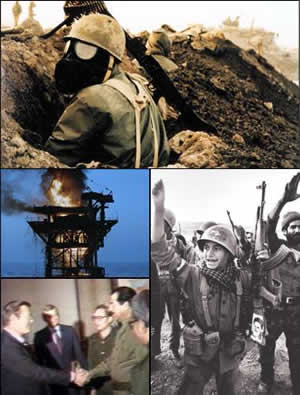The Iran and Iraq War (1980 – 1988) was a war of huge proportions, a war that saw over a million dead in an eight year period of conflict between these neighbouring countries. The questions are how did it happen? Also what was it all about?
It seems that for the last thirty years Iraq has been in some form of conflict, this time period also represents the time that Saddam Hussein was President. Even though Saddam Hussein was seen as a tyrant in recent time is the Iran and Iraq War a war of his warmongering?
Leading up to the Iran and Iraq War
This may come as a surprise to many but the history of this war can actually be traced back to the 16th and 17th centuries. Back in the 16th and 17th centuries the Persians and Ottomans were battling over the Shatt al-Arab waterway found in the Persian Gulf.
This dispute carried on into the twentieth century when Iran and Iraq formally agreed a treaty in 1937, this treaty gave Iraq control of nearly the whole waterway. This treaty stayed in place for just over twenty years, this was until the Iraq leadership was overthrown and a nationalistic General called General Abdul Karim Qassim took control of Iraq.

When General Abdul Karim Qassim succeeded in taking over the leadership of Iraq he formally advised that he did not look at historical Arab tribal decisions. General Abdul Karim Qassim even went as far as to set about trying to gain control of western Iranian lands rich in oil through political means.
Even after the Ba’ath Party gained control of Iraq later on the diplomatic ties between the two countries were still nonexistent. Ties became even worse between Iraq and Iran when Iraq started claiming sovereignty rights over Persian Gulf islands.
Iran decided to exacerbate the situation by declaring itself a patron of the Kurdish rebels in the north of Iraq along the Iraq-Turkish border. Iraq complained to the Arab League and UN on many occasions but there complaints constantly fell on deaf ears.
Iraq never went as far as war with Iran through all this because Iran was a larger country with more military might.
By 1975 Iraq had no choice but to try and normalize ties with Iran and resolve the Kurdish problem using Iran’s help, to do this they signed the 1975 Algiers Agreement that gave Iran land and the much argued over Shatt al-Arab waterway.
In 1978 to 1979 Iran went through its revolution bringing Ayatollah Ruhollah Khomeini to power, initially this was welcomed by Iraq, until the Ayatollah started telling Iraqi Shittes to follow Iran’s revolution and overthrow the ruling Ba’ath party. This time also coincided with a new President in office called Saddam Hussein.
In early 1980 many Ba’ath party officials were assassinated by Iraqi Shittes and an unsuccessful attempt was made on Deputy Prime Minister Tariq Aziz. These assassinations along with more calls from Iran to overthrow the Ba’ath Part from power made Saddam see Iran as a threat that needed neutralising.
By September 1980 Saddam Hussein had decided that something needed to be done so on the 17th September he made a statement to the Iraqi parliament that read: “The frequent and blatant Iranian violations of Iraqi sovereignty…have rendered the 1975 Algiers Agreement null and void… This river…must have its Iraqi-Arab identity restored as it was throughout history in name and in reality with all the disposal rights emanating from full sovereignty over the river.”
Iran and Iraq War (1980 – 1988)
Only 5 days after his address in parliament Iraq invaded Iran, the date was the 22nd September 1980. The invasion involved land forces crossing across the full length of the Iraq-Iran border along with the Iraqi Air Force bombing airbases and Tehran.
The land forces of Iraq enjoyed some success as while the Iran army was greater they were as independent divisions so did not work as a cohesive unit to repel the Iraqi advance. In the same breath the Iraqi Air Force was neutralised in a matter of days and Iran had air superiority for the war.
By 1981 the war was in stalemate with neither side making ground, however in 1982 the Iraqis retreated and Iran was on the offensive, gaining ground as they went.
Another stalemate happened between 1983 and 1984 with many dying on both sides but no real change in fortunes for either country. In 1984 a new type of warfare did emerge as Iraq started targeting Iranian oil tankers hoping to cripple the country economically.
1985 to 1986 saw advances and retreats on both sides, but it was all ineffectual as neither side truly gained any ground in the war. 1987 to 1988 saw Iran make ventures into Iraq to try and capture Basra and other Iraqi cities, of which their main interest was those rich in oil.
By 1988 Iraq changed tactic and started dropping chemical cyanide bombs, first on an Iraqi Kurdish village then on an Iranian Kurdish village. These final acts saw Iran go to the UN and agree the Security Council Resolution 598, the Iraqis also agreed to the resolution and peace was at last found between the two nations.
The war effectively finished as a stalemate with neither country gaining anything from the long conflict. The economic loss on both sides amounted to a total of US $1000 billion. It is estimated that some 300,000 Iraqi soldiers and civilians lost their lives and up to 1,000,000 Iranian soldiers and civilians lost their lives in the conflict.

